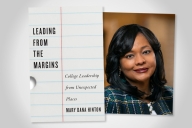You have /5 articles left.
Sign up for a free account or log in.

Students and faculty members at community colleges are reaping the educational and economic benefits of OER, including designing courses collaboratively.
Mars/Unsplash
Students and faculty members at community colleges benefit in many ways from using open educational resources, or OER, and from emphasizing culturally relevant learning practices, according to a report released today. However, the study indicated that the institutions themselves need to commit more fully to OER, both financially and with professional development and structural support for faculty members.
"Teaching and Learning With Open Educational Resources," conducted by SRI Education, a division of the nonprofit research institute SRI International, is based on course observations and interviews with faculty members, students and administrators at eight community colleges that use open educational resources—free learning materials that can be downloaded, used and shared by the students and faculty in lieu of often-costly textbooks and other course materials. Because the study began in 2020, during the pandemic, the surveys and interviews were conducted nearly entirely virtually; they also took place largely in the time period after the social and racial reckonings after the death of George Floyd that shed a new light on diversity and equity in higher education.
The aim of the study, which was conducted for Achieving the Dream, an organization focused on fostering student success at community colleges, was to examine “whether the use of OER is leading to instructional transformation, what OEP [open educational practices] look like in the classroom, and how the use of these practices affects students,” according to the report. A particular focus was placed on “historically marginalized student populations” served by community colleges nationwide.
The report concluded that the adoption of OER gave both teachers and students far more freedom in what they learned and how they learned, and it made students feel more in control of their education, safer in their classroom environments and more culturally connected to the material.
What needs marked improvement, said Karen Stout, president and CEO of Achieving the Dream, is institutional awareness, understanding and support for OER.
“Not every teacher is hitting all the dimensions of effective open and culturally responsive teaching,” Stout said at a media briefing about the report. “This reveals that, for the most part, faculty are going at it on their own, really without systematic supports from their institutions, without professional development and support for their teaching. So there’s an opportunity here for us to think differently, as a sector, about how we invest in faculty professional development in using OER.
“No matter how much work we continue to do to make student support services and the experience of going to college more student-centered, we will never get to the heart of the student success challenge until we support faculty in deepening their ability to bring student-centered, culturally responsive teaching into the classroom,” Stout added.
While the study’s findings are mostly positive, there remain problems nationally with adoption of OER by faculty members themselves. These challenges exist despite efforts by some states and individual colleges, philanthropies and even the federal government to launch initiatives designed to fund the creation and build the awareness and ultimately adoption of high-quality open materials.
Those collective efforts have moved the needle for OER at a time of great upheaval in the textbook market, but other factors have hampered wide embrace of OER, including lack of awareness, faculty inertia, doubts about the quality of OER materials and the diffusion of the OER marketplace and the lack of central structures and advocates for open materials.
Stout said advocates for OER deserve a share of the blame for them not being more widely embraced.
“I’ve often said that this student success movement that ATD is a part of has had a collective blind spot, that improving instruction has too often been on the margins of our institutional efforts to improve student outcomes,” she said.
That is why support from the top is necessary, Stout noted.
“Leadership matters to adoption and scale, and that leadership shows through in strategy and in where resources are allocated,” she said. “Without these things, any of these interventions are just an ad hoc exercise that won’t transform teaching at an institution.”
Richard Sebastian, ATD’s director of open and digital learning, said plans are in the works for webinars, blog posts and workshops to help teach faculty about OER and the conclusions reached in the report. A faculty guide based on the recommendations in the report will also be released.
“We see the guide as kind of an operation manual for the framework,” Sebastian said at the briefing, including “examples from the field, tools and activities, action steps that give faculties multiple ways to weave these concepts into their classrooms.”
The institutions that have learned about OER and have committed to them have seen the results illuminated in the report. For example, Montgomery College in Maryland, which enrolled 15,584 students this spring semester, has started several programs that have embedded OER concepts into the overall teaching foundation and plans to add more.
Shinta Hernandez, dean of Montgomery College’s virtual campus, said that she first used OER five years ago in a sociology class she taught at the college while she was chair of the department of sociology, anthropology and criminal justice. She then recommended that the resources be used throughout her department and then expanded their use when she moved into her current position.
Using her experience as a guide, she recommends that faculty members interested in using OER start small.
“You get a chance to be a part of a community of practice, whether it’s internal or external to the institution, and from there magic can happen,” she said during the briefing. “You brainstorm; you generate ideas. Starting small, sometimes in one’s own classroom, can be the key to a lifetime transformation of teaching and learning.”
Montgomery College now has two OER-based programs that began on its campus but are now used at other institutions across the country—and in other nations through the United Nations Sustainable Development Goals Open Pedagogy Fellowship program, which helps faculty design their OER courses, and the Social Justice Ambassador Program, which helps faculty and students collaborate on designing their own courses.
“I find that it’s comprehensive,” Hernandez said of OER concepts. “I also find that it’s inclusive, because the framework can be applied to all disciplines, not just the disciplines in which open pedagogy or culturally responsive teaching is more natural. It really can be applied to all disciplines … It can be used by anybody in higher education. It can be used by faculty, full-time and part-time, librarians, instructional designers, even institutional leaders.”
ATD’s next step is to work again with SRI Education to partner with the Tennessee Board of Regents to study open and culturally responsible teaching at all levels of higher education in the state. The William and Flora Hewlett Foundation, which funded the OER study and other previous research by ATD, is funding the Tennessee study with an $800,000 grant.
Rebecca Griffiths, senior principal researcher at SRI Education and one of the report’s four co-authors, said the study of OER can potentially push institutions to take full advantage of what OER can produce.
“What we really wanted to get at was how the use of OER could lead to transformative practices, what is possible with OER, in what ways can OER contribute to equity-driven instruction,” Griffiths said. “We really wanted to understand these questions from the faculty perspective, how they think about the kind of changes they’re making, what their goals are, what worries them or holds them back, and along those lines, we wanted to explore the ways in which institutions support or impede their work.”








